Evaluation of Business and Corporate Law Group Report HI6027
VerifiedAdded on 2023/04/03
|11
|2922
|223
Report
AI Summary
This report is a group assignment for the HI6027 Business and Corporate Law course, evaluating two case studies. Part A focuses on the case of Commercial Bank of Australia Ltd v Amadio, examining issues of unconscionable conduct, relevant legal rules, and vicarious liability, including Mr. Virgo's potential liability to his employer and breach of contract. Part B addresses a scenario involving Vesna, a director, and her involvement in contracts, analyzing potential breaches of the Corporations Act 2001 concerning directors' duties, disclosure of interests, and acting in the best interests of the company. The report applies legal principles to the facts, offering conclusions based on the analysis and includes references to relevant legislation and case law.
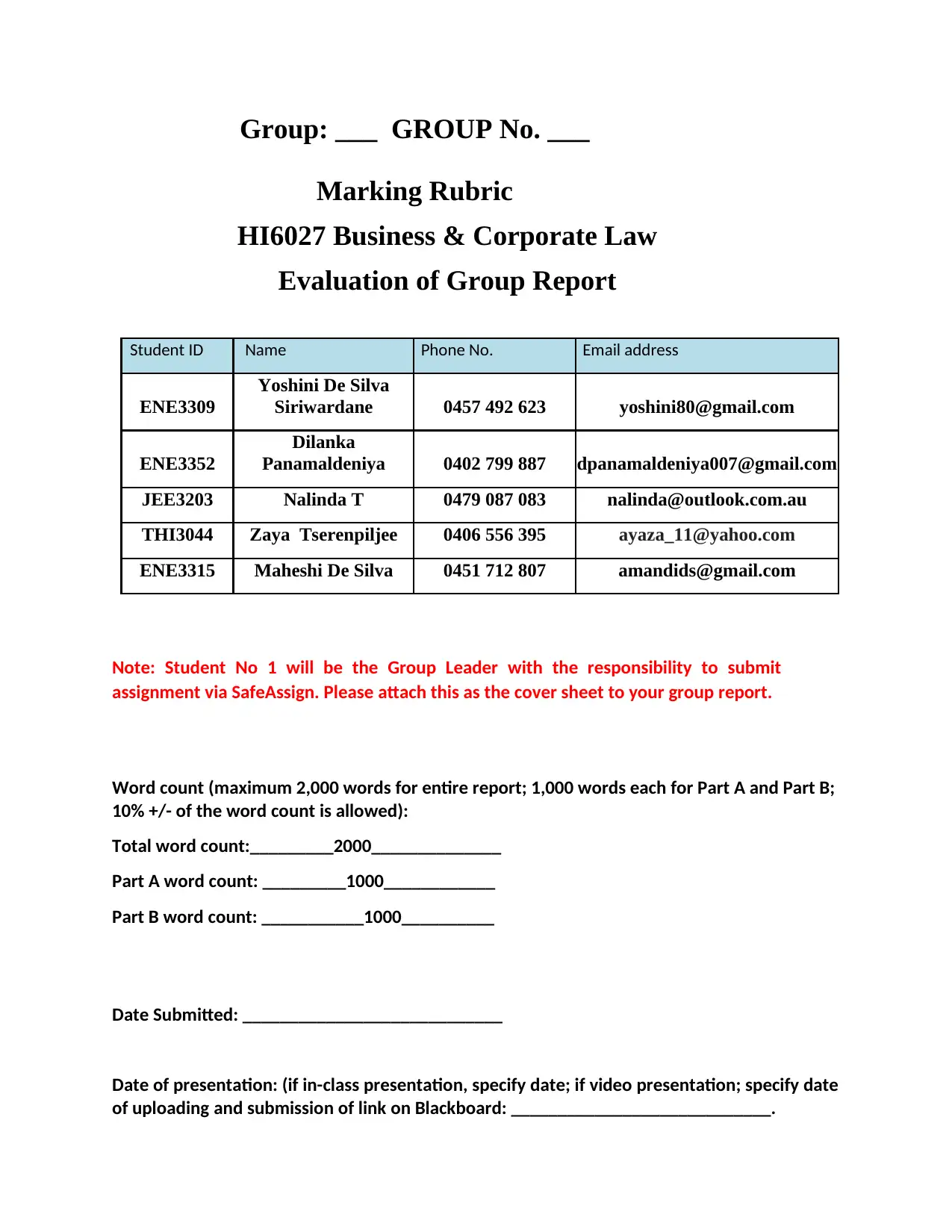
Group: ___ GROUP No. ___
Marking Rubric
HI6027 Business & Corporate Law
Evaluation of Group Report
Student ID Name Phone No. Email address
ENE3309
Yoshini De Silva
Siriwardane 0457 492 623 yoshini80@gmail.com
ENE3352
Dilanka
Panamaldeniya 0402 799 887 dpanamaldeniya007@gmail.com
JEE3203 Nalinda T 0479 087 083 nalinda@outlook.com.au
THI3044 Zaya Tserenpiljee 0406 556 395 ayaza_11@yahoo.com
ENE3315 Maheshi De Silva 0451 712 807 amandids@gmail.com
Note: Student No 1 will be the Group Leader with the responsibility to submit
assignment via SafeAssign. Please attach this as the cover sheet to your group report.
Word count (maximum 2,000 words for entire report; 1,000 words each for Part A and Part B;
10% +/- of the word count is allowed):
Total word count:_________2000______________
Part A word count: _________1000____________
Part B word count: ___________1000__________
Date Submitted: ____________________________
Date of presentation: (if in-class presentation, specify date; if video presentation; specify date
of uploading and submission of link on Blackboard: ____________________________.
Marking Rubric
HI6027 Business & Corporate Law
Evaluation of Group Report
Student ID Name Phone No. Email address
ENE3309
Yoshini De Silva
Siriwardane 0457 492 623 yoshini80@gmail.com
ENE3352
Dilanka
Panamaldeniya 0402 799 887 dpanamaldeniya007@gmail.com
JEE3203 Nalinda T 0479 087 083 nalinda@outlook.com.au
THI3044 Zaya Tserenpiljee 0406 556 395 ayaza_11@yahoo.com
ENE3315 Maheshi De Silva 0451 712 807 amandids@gmail.com
Note: Student No 1 will be the Group Leader with the responsibility to submit
assignment via SafeAssign. Please attach this as the cover sheet to your group report.
Word count (maximum 2,000 words for entire report; 1,000 words each for Part A and Part B;
10% +/- of the word count is allowed):
Total word count:_________2000______________
Part A word count: _________1000____________
Part B word count: ___________1000__________
Date Submitted: ____________________________
Date of presentation: (if in-class presentation, specify date; if video presentation; specify date
of uploading and submission of link on Blackboard: ____________________________.
Paraphrase This Document
Need a fresh take? Get an instant paraphrase of this document with our AI Paraphraser

GROUP ASSIGNMENT TOTAL MARKS 20
1. Observes proper report formatting: 12 point
font, 1.5 lines spacing.
/1
2. Identification of relevant legal issues. /2
3. Identification of relevant legal rules and
principles.
/4
4. Application of relevant legal rules and
principles to facts of the problem question.
/4
5. Makes appropriate conclusion based on
analysis of the problem question.
/2
6. References: (minimum of 6 overall; 3 each
for Parts A & B), in-text citation and reference
list.
/2
7. Group Presentation /5
1
1. Observes proper report formatting: 12 point
font, 1.5 lines spacing.
/1
2. Identification of relevant legal issues. /2
3. Identification of relevant legal rules and
principles.
/4
4. Application of relevant legal rules and
principles to facts of the problem question.
/4
5. Makes appropriate conclusion based on
analysis of the problem question.
/2
6. References: (minimum of 6 overall; 3 each
for Parts A & B), in-text citation and reference
list.
/2
7. Group Presentation /5
1
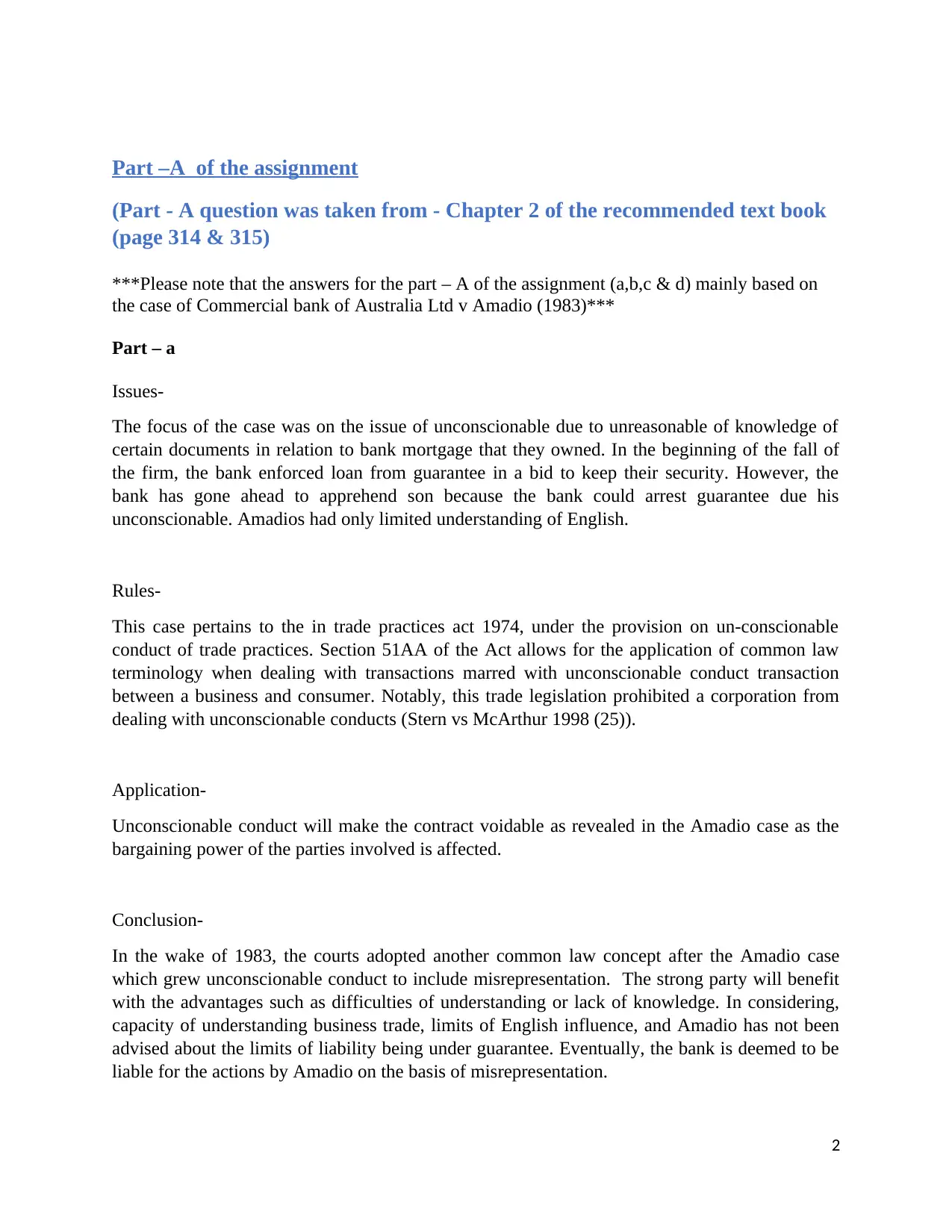
Part –A of the assignment
(Part - A question was taken from - Chapter 2 of the recommended text book
(page 314 & 315)
***Please note that the answers for the part – A of the assignment (a,b,c & d) mainly based on
the case of Commercial bank of Australia Ltd v Amadio (1983)***
Part – a
Issues-
The focus of the case was on the issue of unconscionable due to unreasonable of knowledge of
certain documents in relation to bank mortgage that they owned. In the beginning of the fall of
the firm, the bank enforced loan from guarantee in a bid to keep their security. However, the
bank has gone ahead to apprehend son because the bank could arrest guarantee due his
unconscionable. Amadios had only limited understanding of English.
Rules-
This case pertains to the in trade practices act 1974, under the provision on un-conscionable
conduct of trade practices. Section 51AA of the Act allows for the application of common law
terminology when dealing with transactions marred with unconscionable conduct transaction
between a business and consumer. Notably, this trade legislation prohibited a corporation from
dealing with unconscionable conducts (Stern vs McArthur 1998 (25)).
Application-
Unconscionable conduct will make the contract voidable as revealed in the Amadio case as the
bargaining power of the parties involved is affected.
Conclusion-
In the wake of 1983, the courts adopted another common law concept after the Amadio case
which grew unconscionable conduct to include misrepresentation. The strong party will benefit
with the advantages such as difficulties of understanding or lack of knowledge. In considering,
capacity of understanding business trade, limits of English influence, and Amadio has not been
advised about the limits of liability being under guarantee. Eventually, the bank is deemed to be
liable for the actions by Amadio on the basis of misrepresentation.
2
(Part - A question was taken from - Chapter 2 of the recommended text book
(page 314 & 315)
***Please note that the answers for the part – A of the assignment (a,b,c & d) mainly based on
the case of Commercial bank of Australia Ltd v Amadio (1983)***
Part – a
Issues-
The focus of the case was on the issue of unconscionable due to unreasonable of knowledge of
certain documents in relation to bank mortgage that they owned. In the beginning of the fall of
the firm, the bank enforced loan from guarantee in a bid to keep their security. However, the
bank has gone ahead to apprehend son because the bank could arrest guarantee due his
unconscionable. Amadios had only limited understanding of English.
Rules-
This case pertains to the in trade practices act 1974, under the provision on un-conscionable
conduct of trade practices. Section 51AA of the Act allows for the application of common law
terminology when dealing with transactions marred with unconscionable conduct transaction
between a business and consumer. Notably, this trade legislation prohibited a corporation from
dealing with unconscionable conducts (Stern vs McArthur 1998 (25)).
Application-
Unconscionable conduct will make the contract voidable as revealed in the Amadio case as the
bargaining power of the parties involved is affected.
Conclusion-
In the wake of 1983, the courts adopted another common law concept after the Amadio case
which grew unconscionable conduct to include misrepresentation. The strong party will benefit
with the advantages such as difficulties of understanding or lack of knowledge. In considering,
capacity of understanding business trade, limits of English influence, and Amadio has not been
advised about the limits of liability being under guarantee. Eventually, the bank is deemed to be
liable for the actions by Amadio on the basis of misrepresentation.
2
⊘ This is a preview!⊘
Do you want full access?
Subscribe today to unlock all pages.

Trusted by 1+ million students worldwide
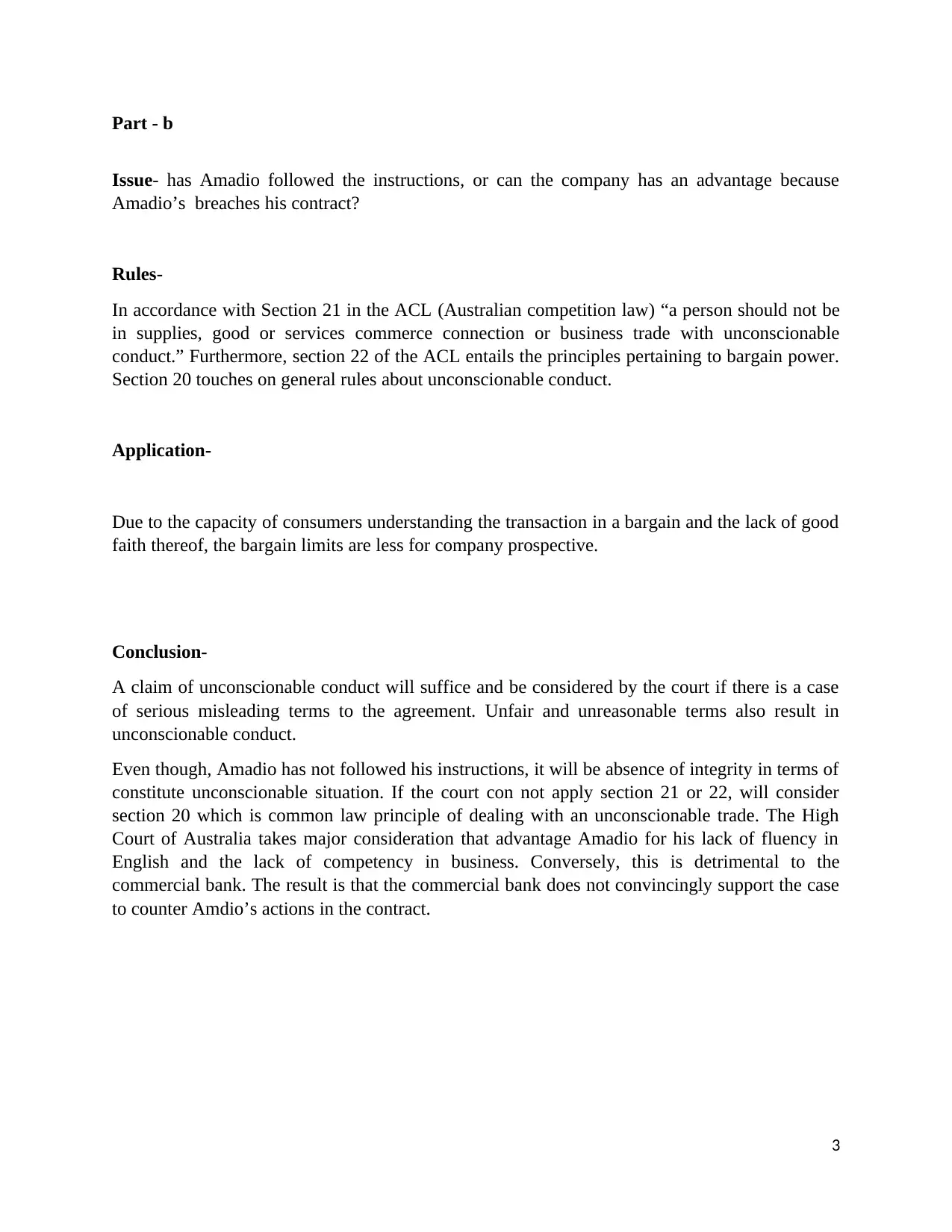
Part - b
Issue- has Amadio followed the instructions, or can the company has an advantage because
Amadio’s breaches his contract?
Rules-
In accordance with Section 21 in the ACL (Australian competition law) “a person should not be
in supplies, good or services commerce connection or business trade with unconscionable
conduct.” Furthermore, section 22 of the ACL entails the principles pertaining to bargain power.
Section 20 touches on general rules about unconscionable conduct.
Application-
Due to the capacity of consumers understanding the transaction in a bargain and the lack of good
faith thereof, the bargain limits are less for company prospective.
Conclusion-
A claim of unconscionable conduct will suffice and be considered by the court if there is a case
of serious misleading terms to the agreement. Unfair and unreasonable terms also result in
unconscionable conduct.
Even though, Amadio has not followed his instructions, it will be absence of integrity in terms of
constitute unconscionable situation. If the court con not apply section 21 or 22, will consider
section 20 which is common law principle of dealing with an unconscionable trade. The High
Court of Australia takes major consideration that advantage Amadio for his lack of fluency in
English and the lack of competency in business. Conversely, this is detrimental to the
commercial bank. The result is that the commercial bank does not convincingly support the case
to counter Amdio’s actions in the contract.
3
Issue- has Amadio followed the instructions, or can the company has an advantage because
Amadio’s breaches his contract?
Rules-
In accordance with Section 21 in the ACL (Australian competition law) “a person should not be
in supplies, good or services commerce connection or business trade with unconscionable
conduct.” Furthermore, section 22 of the ACL entails the principles pertaining to bargain power.
Section 20 touches on general rules about unconscionable conduct.
Application-
Due to the capacity of consumers understanding the transaction in a bargain and the lack of good
faith thereof, the bargain limits are less for company prospective.
Conclusion-
A claim of unconscionable conduct will suffice and be considered by the court if there is a case
of serious misleading terms to the agreement. Unfair and unreasonable terms also result in
unconscionable conduct.
Even though, Amadio has not followed his instructions, it will be absence of integrity in terms of
constitute unconscionable situation. If the court con not apply section 21 or 22, will consider
section 20 which is common law principle of dealing with an unconscionable trade. The High
Court of Australia takes major consideration that advantage Amadio for his lack of fluency in
English and the lack of competency in business. Conversely, this is detrimental to the
commercial bank. The result is that the commercial bank does not convincingly support the case
to counter Amdio’s actions in the contract.
3
Paraphrase This Document
Need a fresh take? Get an instant paraphrase of this document with our AI Paraphraser
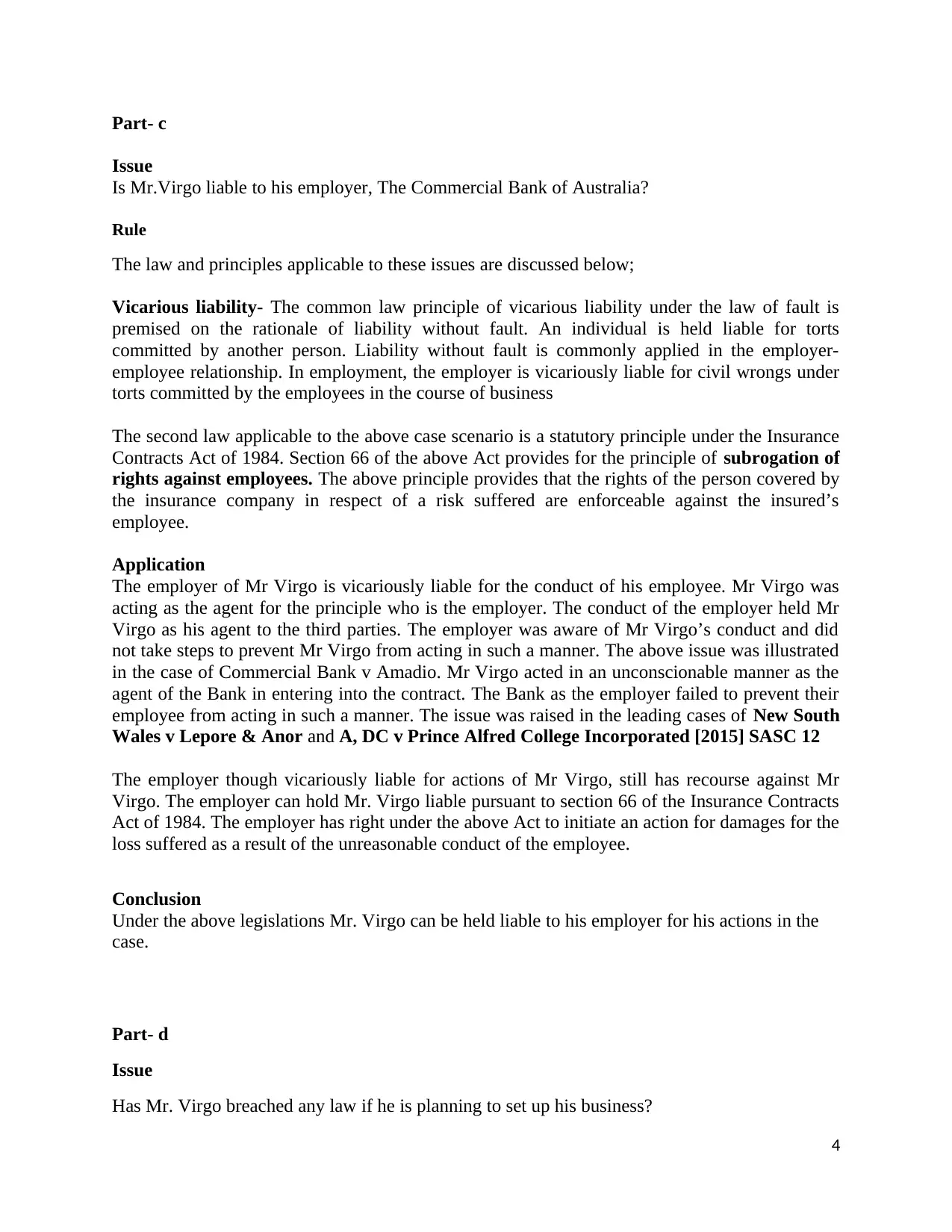
Part- c
Issue
Is Mr.Virgo liable to his employer, The Commercial Bank of Australia?
Rule
The law and principles applicable to these issues are discussed below;
Vicarious liability- The common law principle of vicarious liability under the law of fault is
premised on the rationale of liability without fault. An individual is held liable for torts
committed by another person. Liability without fault is commonly applied in the employer-
employee relationship. In employment, the employer is vicariously liable for civil wrongs under
torts committed by the employees in the course of business
The second law applicable to the above case scenario is a statutory principle under the Insurance
Contracts Act of 1984. Section 66 of the above Act provides for the principle of subrogation of
rights against employees. The above principle provides that the rights of the person covered by
the insurance company in respect of a risk suffered are enforceable against the insured’s
employee.
Application
The employer of Mr Virgo is vicariously liable for the conduct of his employee. Mr Virgo was
acting as the agent for the principle who is the employer. The conduct of the employer held Mr
Virgo as his agent to the third parties. The employer was aware of Mr Virgo’s conduct and did
not take steps to prevent Mr Virgo from acting in such a manner. The above issue was illustrated
in the case of Commercial Bank v Amadio. Mr Virgo acted in an unconscionable manner as the
agent of the Bank in entering into the contract. The Bank as the employer failed to prevent their
employee from acting in such a manner. The issue was raised in the leading cases of New South
Wales v Lepore & Anor and A, DC v Prince Alfred College Incorporated [2015] SASC 12
The employer though vicariously liable for actions of Mr Virgo, still has recourse against Mr
Virgo. The employer can hold Mr. Virgo liable pursuant to section 66 of the Insurance Contracts
Act of 1984. The employer has right under the above Act to initiate an action for damages for the
loss suffered as a result of the unreasonable conduct of the employee.
Conclusion
Under the above legislations Mr. Virgo can be held liable to his employer for his actions in the
case.
Part- d
Issue
Has Mr. Virgo breached any law if he is planning to set up his business?
4
Issue
Is Mr.Virgo liable to his employer, The Commercial Bank of Australia?
Rule
The law and principles applicable to these issues are discussed below;
Vicarious liability- The common law principle of vicarious liability under the law of fault is
premised on the rationale of liability without fault. An individual is held liable for torts
committed by another person. Liability without fault is commonly applied in the employer-
employee relationship. In employment, the employer is vicariously liable for civil wrongs under
torts committed by the employees in the course of business
The second law applicable to the above case scenario is a statutory principle under the Insurance
Contracts Act of 1984. Section 66 of the above Act provides for the principle of subrogation of
rights against employees. The above principle provides that the rights of the person covered by
the insurance company in respect of a risk suffered are enforceable against the insured’s
employee.
Application
The employer of Mr Virgo is vicariously liable for the conduct of his employee. Mr Virgo was
acting as the agent for the principle who is the employer. The conduct of the employer held Mr
Virgo as his agent to the third parties. The employer was aware of Mr Virgo’s conduct and did
not take steps to prevent Mr Virgo from acting in such a manner. The above issue was illustrated
in the case of Commercial Bank v Amadio. Mr Virgo acted in an unconscionable manner as the
agent of the Bank in entering into the contract. The Bank as the employer failed to prevent their
employee from acting in such a manner. The issue was raised in the leading cases of New South
Wales v Lepore & Anor and A, DC v Prince Alfred College Incorporated [2015] SASC 12
The employer though vicariously liable for actions of Mr Virgo, still has recourse against Mr
Virgo. The employer can hold Mr. Virgo liable pursuant to section 66 of the Insurance Contracts
Act of 1984. The employer has right under the above Act to initiate an action for damages for the
loss suffered as a result of the unreasonable conduct of the employee.
Conclusion
Under the above legislations Mr. Virgo can be held liable to his employer for his actions in the
case.
Part- d
Issue
Has Mr. Virgo breached any law if he is planning to set up his business?
4
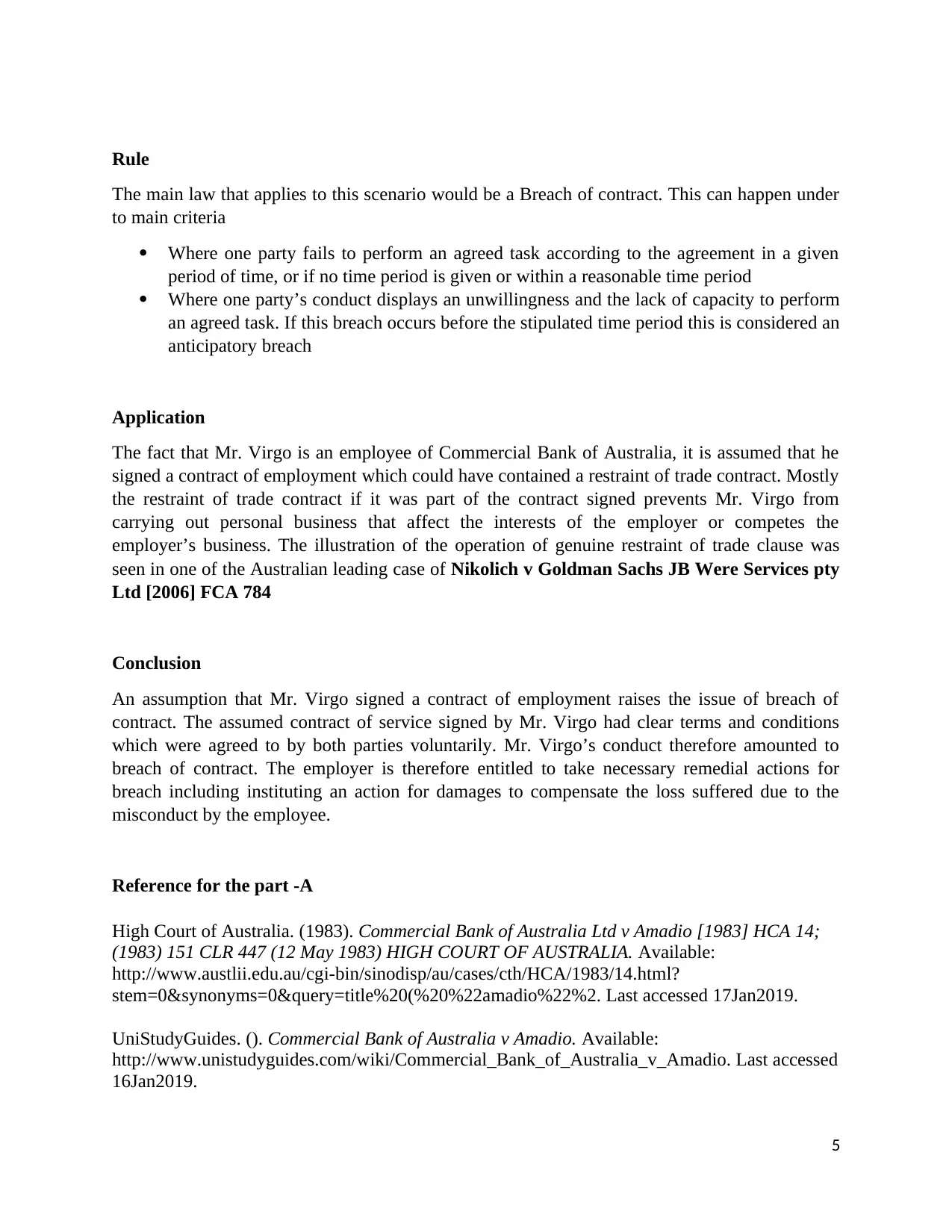
Rule
The main law that applies to this scenario would be a Breach of contract. This can happen under
to main criteria
Where one party fails to perform an agreed task according to the agreement in a given
period of time, or if no time period is given or within a reasonable time period
Where one party’s conduct displays an unwillingness and the lack of capacity to perform
an agreed task. If this breach occurs before the stipulated time period this is considered an
anticipatory breach
Application
The fact that Mr. Virgo is an employee of Commercial Bank of Australia, it is assumed that he
signed a contract of employment which could have contained a restraint of trade contract. Mostly
the restraint of trade contract if it was part of the contract signed prevents Mr. Virgo from
carrying out personal business that affect the interests of the employer or competes the
employer’s business. The illustration of the operation of genuine restraint of trade clause was
seen in one of the Australian leading case of Nikolich v Goldman Sachs JB Were Services pty
Ltd [2006] FCA 784
Conclusion
An assumption that Mr. Virgo signed a contract of employment raises the issue of breach of
contract. The assumed contract of service signed by Mr. Virgo had clear terms and conditions
which were agreed to by both parties voluntarily. Mr. Virgo’s conduct therefore amounted to
breach of contract. The employer is therefore entitled to take necessary remedial actions for
breach including instituting an action for damages to compensate the loss suffered due to the
misconduct by the employee.
Reference for the part -A
High Court of Australia. (1983). Commercial Bank of Australia Ltd v Amadio [1983] HCA 14;
(1983) 151 CLR 447 (12 May 1983) HIGH COURT OF AUSTRALIA. Available:
http://www.austlii.edu.au/cgi-bin/sinodisp/au/cases/cth/HCA/1983/14.html?
stem=0&synonyms=0&query=title%20(%20%22amadio%22%2. Last accessed 17Jan2019.
UniStudyGuides. (). Commercial Bank of Australia v Amadio. Available:
http://www.unistudyguides.com/wiki/Commercial_Bank_of_Australia_v_Amadio. Last accessed
16Jan2019.
5
The main law that applies to this scenario would be a Breach of contract. This can happen under
to main criteria
Where one party fails to perform an agreed task according to the agreement in a given
period of time, or if no time period is given or within a reasonable time period
Where one party’s conduct displays an unwillingness and the lack of capacity to perform
an agreed task. If this breach occurs before the stipulated time period this is considered an
anticipatory breach
Application
The fact that Mr. Virgo is an employee of Commercial Bank of Australia, it is assumed that he
signed a contract of employment which could have contained a restraint of trade contract. Mostly
the restraint of trade contract if it was part of the contract signed prevents Mr. Virgo from
carrying out personal business that affect the interests of the employer or competes the
employer’s business. The illustration of the operation of genuine restraint of trade clause was
seen in one of the Australian leading case of Nikolich v Goldman Sachs JB Were Services pty
Ltd [2006] FCA 784
Conclusion
An assumption that Mr. Virgo signed a contract of employment raises the issue of breach of
contract. The assumed contract of service signed by Mr. Virgo had clear terms and conditions
which were agreed to by both parties voluntarily. Mr. Virgo’s conduct therefore amounted to
breach of contract. The employer is therefore entitled to take necessary remedial actions for
breach including instituting an action for damages to compensate the loss suffered due to the
misconduct by the employee.
Reference for the part -A
High Court of Australia. (1983). Commercial Bank of Australia Ltd v Amadio [1983] HCA 14;
(1983) 151 CLR 447 (12 May 1983) HIGH COURT OF AUSTRALIA. Available:
http://www.austlii.edu.au/cgi-bin/sinodisp/au/cases/cth/HCA/1983/14.html?
stem=0&synonyms=0&query=title%20(%20%22amadio%22%2. Last accessed 17Jan2019.
UniStudyGuides. (). Commercial Bank of Australia v Amadio. Available:
http://www.unistudyguides.com/wiki/Commercial_Bank_of_Australia_v_Amadio. Last accessed
16Jan2019.
5
⊘ This is a preview!⊘
Do you want full access?
Subscribe today to unlock all pages.

Trusted by 1+ million students worldwide
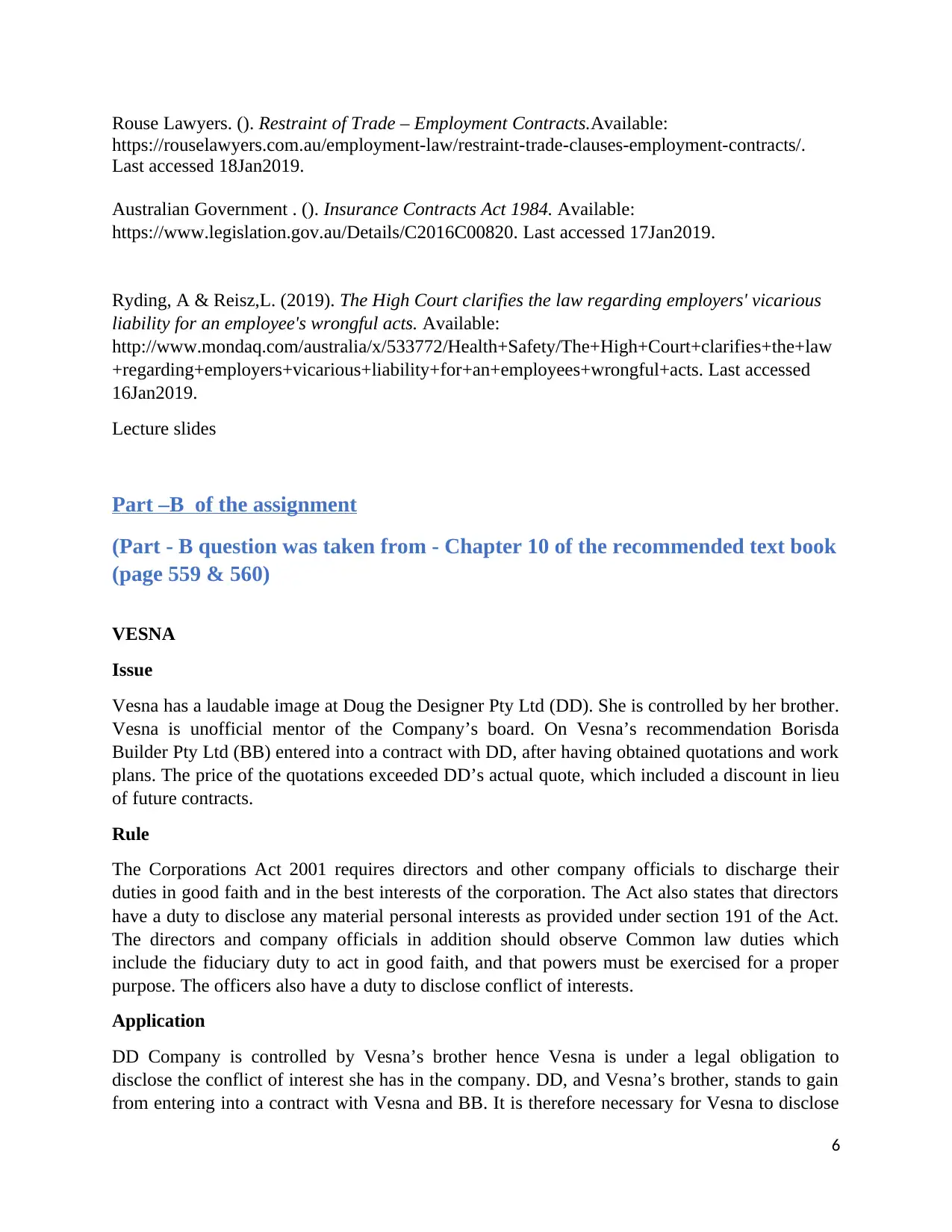
Rouse Lawyers. (). Restraint of Trade – Employment Contracts.Available:
https://rouselawyers.com.au/employment-law/restraint-trade-clauses-employment-contracts/.
Last accessed 18Jan2019.
Australian Government . (). Insurance Contracts Act 1984. Available:
https://www.legislation.gov.au/Details/C2016C00820. Last accessed 17Jan2019.
Ryding, A & Reisz,L. (2019). The High Court clarifies the law regarding employers' vicarious
liability for an employee's wrongful acts. Available:
http://www.mondaq.com/australia/x/533772/Health+Safety/The+High+Court+clarifies+the+law
+regarding+employers+vicarious+liability+for+an+employees+wrongful+acts. Last accessed
16Jan2019.
Lecture slides
Part –B of the assignment
(Part - B question was taken from - Chapter 10 of the recommended text book
(page 559 & 560)
VESNA
Issue
Vesna has a laudable image at Doug the Designer Pty Ltd (DD). She is controlled by her brother.
Vesna is unofficial mentor of the Company’s board. On Vesna’s recommendation Borisda
Builder Pty Ltd (BB) entered into a contract with DD, after having obtained quotations and work
plans. The price of the quotations exceeded DD’s actual quote, which included a discount in lieu
of future contracts.
Rule
The Corporations Act 2001 requires directors and other company officials to discharge their
duties in good faith and in the best interests of the corporation. The Act also states that directors
have a duty to disclose any material personal interests as provided under section 191 of the Act.
The directors and company officials in addition should observe Common law duties which
include the fiduciary duty to act in good faith, and that powers must be exercised for a proper
purpose. The officers also have a duty to disclose conflict of interests.
Application
DD Company is controlled by Vesna’s brother hence Vesna is under a legal obligation to
disclose the conflict of interest she has in the company. DD, and Vesna’s brother, stands to gain
from entering into a contract with Vesna and BB. It is therefore necessary for Vesna to disclose
6
https://rouselawyers.com.au/employment-law/restraint-trade-clauses-employment-contracts/.
Last accessed 18Jan2019.
Australian Government . (). Insurance Contracts Act 1984. Available:
https://www.legislation.gov.au/Details/C2016C00820. Last accessed 17Jan2019.
Ryding, A & Reisz,L. (2019). The High Court clarifies the law regarding employers' vicarious
liability for an employee's wrongful acts. Available:
http://www.mondaq.com/australia/x/533772/Health+Safety/The+High+Court+clarifies+the+law
+regarding+employers+vicarious+liability+for+an+employees+wrongful+acts. Last accessed
16Jan2019.
Lecture slides
Part –B of the assignment
(Part - B question was taken from - Chapter 10 of the recommended text book
(page 559 & 560)
VESNA
Issue
Vesna has a laudable image at Doug the Designer Pty Ltd (DD). She is controlled by her brother.
Vesna is unofficial mentor of the Company’s board. On Vesna’s recommendation Borisda
Builder Pty Ltd (BB) entered into a contract with DD, after having obtained quotations and work
plans. The price of the quotations exceeded DD’s actual quote, which included a discount in lieu
of future contracts.
Rule
The Corporations Act 2001 requires directors and other company officials to discharge their
duties in good faith and in the best interests of the corporation. The Act also states that directors
have a duty to disclose any material personal interests as provided under section 191 of the Act.
The directors and company officials in addition should observe Common law duties which
include the fiduciary duty to act in good faith, and that powers must be exercised for a proper
purpose. The officers also have a duty to disclose conflict of interests.
Application
DD Company is controlled by Vesna’s brother hence Vesna is under a legal obligation to
disclose the conflict of interest she has in the company. DD, and Vesna’s brother, stands to gain
from entering into a contract with Vesna and BB. It is therefore necessary for Vesna to disclose
6
Paraphrase This Document
Need a fresh take? Get an instant paraphrase of this document with our AI Paraphraser
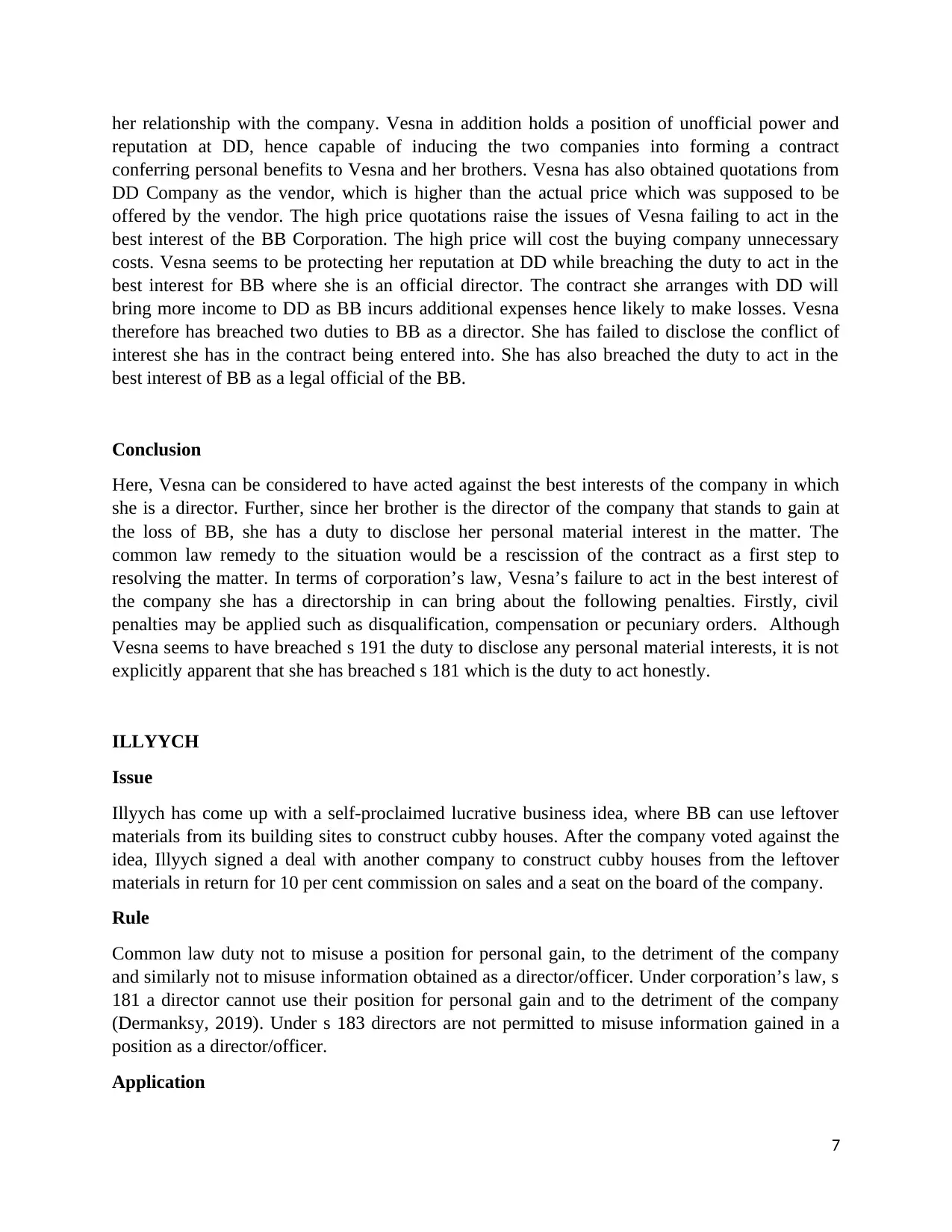
her relationship with the company. Vesna in addition holds a position of unofficial power and
reputation at DD, hence capable of inducing the two companies into forming a contract
conferring personal benefits to Vesna and her brothers. Vesna has also obtained quotations from
DD Company as the vendor, which is higher than the actual price which was supposed to be
offered by the vendor. The high price quotations raise the issues of Vesna failing to act in the
best interest of the BB Corporation. The high price will cost the buying company unnecessary
costs. Vesna seems to be protecting her reputation at DD while breaching the duty to act in the
best interest for BB where she is an official director. The contract she arranges with DD will
bring more income to DD as BB incurs additional expenses hence likely to make losses. Vesna
therefore has breached two duties to BB as a director. She has failed to disclose the conflict of
interest she has in the contract being entered into. She has also breached the duty to act in the
best interest of BB as a legal official of the BB.
Conclusion
Here, Vesna can be considered to have acted against the best interests of the company in which
she is a director. Further, since her brother is the director of the company that stands to gain at
the loss of BB, she has a duty to disclose her personal material interest in the matter. The
common law remedy to the situation would be a rescission of the contract as a first step to
resolving the matter. In terms of corporation’s law, Vesna’s failure to act in the best interest of
the company she has a directorship in can bring about the following penalties. Firstly, civil
penalties may be applied such as disqualification, compensation or pecuniary orders. Although
Vesna seems to have breached s 191 the duty to disclose any personal material interests, it is not
explicitly apparent that she has breached s 181 which is the duty to act honestly.
ILLYYCH
Issue
Illyych has come up with a self-proclaimed lucrative business idea, where BB can use leftover
materials from its building sites to construct cubby houses. After the company voted against the
idea, Illyych signed a deal with another company to construct cubby houses from the leftover
materials in return for 10 per cent commission on sales and a seat on the board of the company.
Rule
Common law duty not to misuse a position for personal gain, to the detriment of the company
and similarly not to misuse information obtained as a director/officer. Under corporation’s law, s
181 a director cannot use their position for personal gain and to the detriment of the company
(Dermanksy, 2019). Under s 183 directors are not permitted to misuse information gained in a
position as a director/officer.
Application
7
reputation at DD, hence capable of inducing the two companies into forming a contract
conferring personal benefits to Vesna and her brothers. Vesna has also obtained quotations from
DD Company as the vendor, which is higher than the actual price which was supposed to be
offered by the vendor. The high price quotations raise the issues of Vesna failing to act in the
best interest of the BB Corporation. The high price will cost the buying company unnecessary
costs. Vesna seems to be protecting her reputation at DD while breaching the duty to act in the
best interest for BB where she is an official director. The contract she arranges with DD will
bring more income to DD as BB incurs additional expenses hence likely to make losses. Vesna
therefore has breached two duties to BB as a director. She has failed to disclose the conflict of
interest she has in the contract being entered into. She has also breached the duty to act in the
best interest of BB as a legal official of the BB.
Conclusion
Here, Vesna can be considered to have acted against the best interests of the company in which
she is a director. Further, since her brother is the director of the company that stands to gain at
the loss of BB, she has a duty to disclose her personal material interest in the matter. The
common law remedy to the situation would be a rescission of the contract as a first step to
resolving the matter. In terms of corporation’s law, Vesna’s failure to act in the best interest of
the company she has a directorship in can bring about the following penalties. Firstly, civil
penalties may be applied such as disqualification, compensation or pecuniary orders. Although
Vesna seems to have breached s 191 the duty to disclose any personal material interests, it is not
explicitly apparent that she has breached s 181 which is the duty to act honestly.
ILLYYCH
Issue
Illyych has come up with a self-proclaimed lucrative business idea, where BB can use leftover
materials from its building sites to construct cubby houses. After the company voted against the
idea, Illyych signed a deal with another company to construct cubby houses from the leftover
materials in return for 10 per cent commission on sales and a seat on the board of the company.
Rule
Common law duty not to misuse a position for personal gain, to the detriment of the company
and similarly not to misuse information obtained as a director/officer. Under corporation’s law, s
181 a director cannot use their position for personal gain and to the detriment of the company
(Dermanksy, 2019). Under s 183 directors are not permitted to misuse information gained in a
position as a director/officer.
Application
7
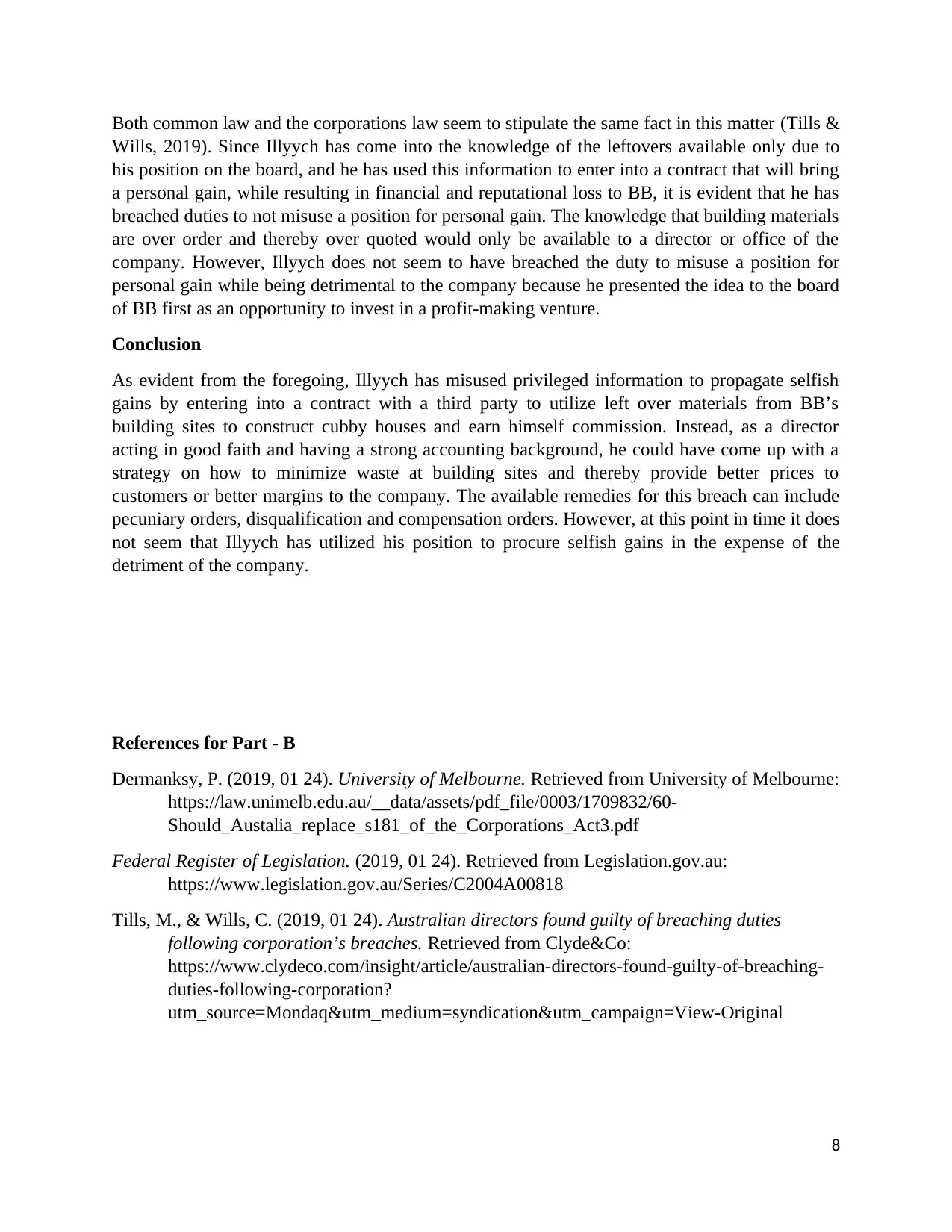
Both common law and the corporations law seem to stipulate the same fact in this matter (Tills &
Wills, 2019). Since Illyych has come into the knowledge of the leftovers available only due to
his position on the board, and he has used this information to enter into a contract that will bring
a personal gain, while resulting in financial and reputational loss to BB, it is evident that he has
breached duties to not misuse a position for personal gain. The knowledge that building materials
are over order and thereby over quoted would only be available to a director or office of the
company. However, Illyych does not seem to have breached the duty to misuse a position for
personal gain while being detrimental to the company because he presented the idea to the board
of BB first as an opportunity to invest in a profit-making venture.
Conclusion
As evident from the foregoing, Illyych has misused privileged information to propagate selfish
gains by entering into a contract with a third party to utilize left over materials from BB’s
building sites to construct cubby houses and earn himself commission. Instead, as a director
acting in good faith and having a strong accounting background, he could have come up with a
strategy on how to minimize waste at building sites and thereby provide better prices to
customers or better margins to the company. The available remedies for this breach can include
pecuniary orders, disqualification and compensation orders. However, at this point in time it does
not seem that Illyych has utilized his position to procure selfish gains in the expense of the
detriment of the company.
References for Part - B
Dermanksy, P. (2019, 01 24). University of Melbourne. Retrieved from University of Melbourne:
https://law.unimelb.edu.au/__data/assets/pdf_file/0003/1709832/60-
Should_Austalia_replace_s181_of_the_Corporations_Act3.pdf
Federal Register of Legislation. (2019, 01 24). Retrieved from Legislation.gov.au:
https://www.legislation.gov.au/Series/C2004A00818
Tills, M., & Wills, C. (2019, 01 24). Australian directors found guilty of breaching duties
following corporation’s breaches. Retrieved from Clyde&Co:
https://www.clydeco.com/insight/article/australian-directors-found-guilty-of-breaching-
duties-following-corporation?
utm_source=Mondaq&utm_medium=syndication&utm_campaign=View-Original
8
Wills, 2019). Since Illyych has come into the knowledge of the leftovers available only due to
his position on the board, and he has used this information to enter into a contract that will bring
a personal gain, while resulting in financial and reputational loss to BB, it is evident that he has
breached duties to not misuse a position for personal gain. The knowledge that building materials
are over order and thereby over quoted would only be available to a director or office of the
company. However, Illyych does not seem to have breached the duty to misuse a position for
personal gain while being detrimental to the company because he presented the idea to the board
of BB first as an opportunity to invest in a profit-making venture.
Conclusion
As evident from the foregoing, Illyych has misused privileged information to propagate selfish
gains by entering into a contract with a third party to utilize left over materials from BB’s
building sites to construct cubby houses and earn himself commission. Instead, as a director
acting in good faith and having a strong accounting background, he could have come up with a
strategy on how to minimize waste at building sites and thereby provide better prices to
customers or better margins to the company. The available remedies for this breach can include
pecuniary orders, disqualification and compensation orders. However, at this point in time it does
not seem that Illyych has utilized his position to procure selfish gains in the expense of the
detriment of the company.
References for Part - B
Dermanksy, P. (2019, 01 24). University of Melbourne. Retrieved from University of Melbourne:
https://law.unimelb.edu.au/__data/assets/pdf_file/0003/1709832/60-
Should_Austalia_replace_s181_of_the_Corporations_Act3.pdf
Federal Register of Legislation. (2019, 01 24). Retrieved from Legislation.gov.au:
https://www.legislation.gov.au/Series/C2004A00818
Tills, M., & Wills, C. (2019, 01 24). Australian directors found guilty of breaching duties
following corporation’s breaches. Retrieved from Clyde&Co:
https://www.clydeco.com/insight/article/australian-directors-found-guilty-of-breaching-
duties-following-corporation?
utm_source=Mondaq&utm_medium=syndication&utm_campaign=View-Original
8
⊘ This is a preview!⊘
Do you want full access?
Subscribe today to unlock all pages.

Trusted by 1+ million students worldwide
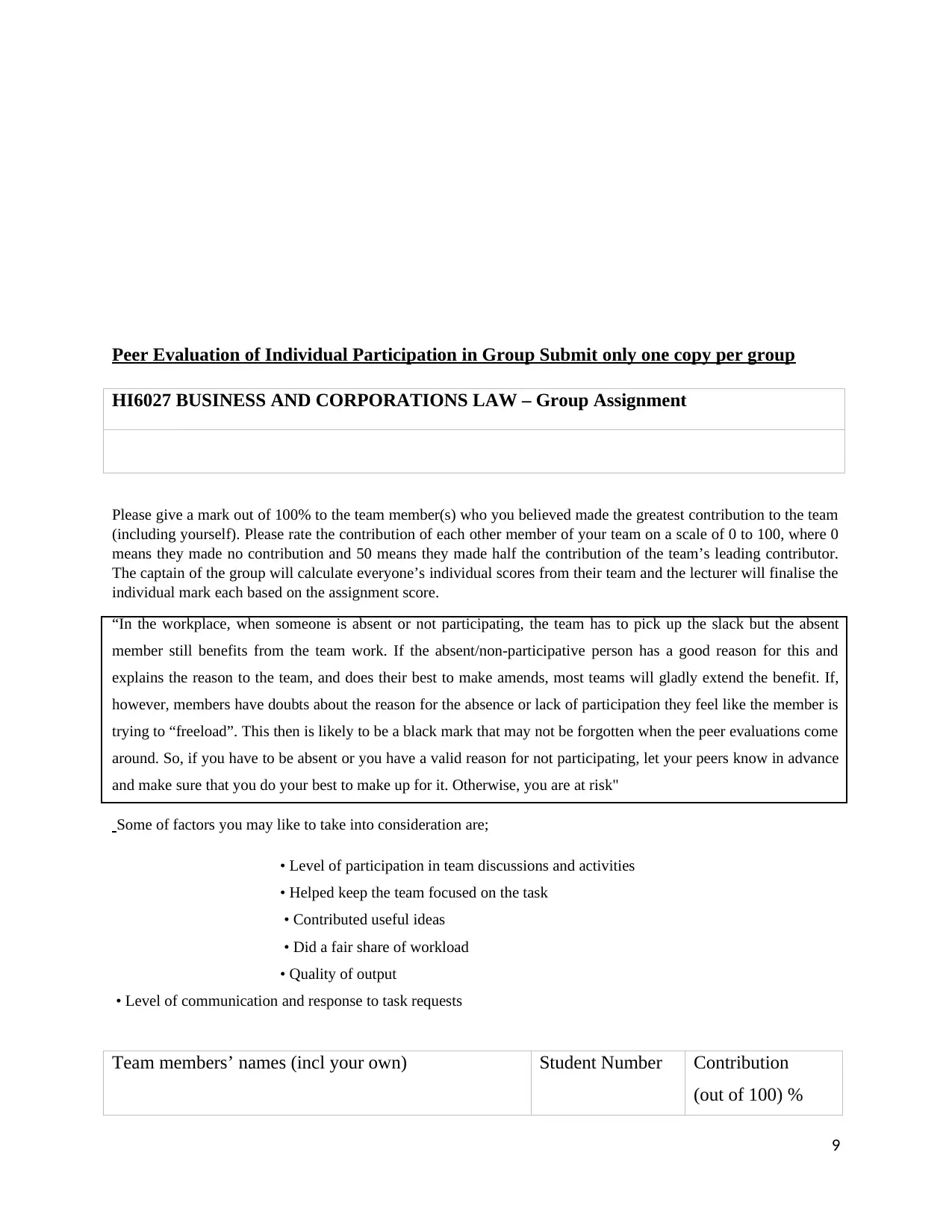
Peer Evaluation of Individual Participation in Group Submit only one copy per group
HI6027 BUSINESS AND CORPORATIONS LAW – Group Assignment
Please give a mark out of 100% to the team member(s) who you believed made the greatest contribution to the team
(including yourself). Please rate the contribution of each other member of your team on a scale of 0 to 100, where 0
means they made no contribution and 50 means they made half the contribution of the team’s leading contributor.
The captain of the group will calculate everyone’s individual scores from their team and the lecturer will finalise the
individual mark each based on the assignment score.
“In the workplace, when someone is absent or not participating, the team has to pick up the slack but the absent
member still benefits from the team work. If the absent/non-participative person has a good reason for this and
explains the reason to the team, and does their best to make amends, most teams will gladly extend the benefit. If,
however, members have doubts about the reason for the absence or lack of participation they feel like the member is
trying to “freeload”. This then is likely to be a black mark that may not be forgotten when the peer evaluations come
around. So, if you have to be absent or you have a valid reason for not participating, let your peers know in advance
and make sure that you do your best to make up for it. Otherwise, you are at risk"
Some of factors you may like to take into consideration are;
• Level of participation in team discussions and activities
• Helped keep the team focused on the task
• Contributed useful ideas
• Did a fair share of workload
• Quality of output
• Level of communication and response to task requests
Team members’ names (incl your own) Student Number Contribution
(out of 100) %
9
HI6027 BUSINESS AND CORPORATIONS LAW – Group Assignment
Please give a mark out of 100% to the team member(s) who you believed made the greatest contribution to the team
(including yourself). Please rate the contribution of each other member of your team on a scale of 0 to 100, where 0
means they made no contribution and 50 means they made half the contribution of the team’s leading contributor.
The captain of the group will calculate everyone’s individual scores from their team and the lecturer will finalise the
individual mark each based on the assignment score.
“In the workplace, when someone is absent or not participating, the team has to pick up the slack but the absent
member still benefits from the team work. If the absent/non-participative person has a good reason for this and
explains the reason to the team, and does their best to make amends, most teams will gladly extend the benefit. If,
however, members have doubts about the reason for the absence or lack of participation they feel like the member is
trying to “freeload”. This then is likely to be a black mark that may not be forgotten when the peer evaluations come
around. So, if you have to be absent or you have a valid reason for not participating, let your peers know in advance
and make sure that you do your best to make up for it. Otherwise, you are at risk"
Some of factors you may like to take into consideration are;
• Level of participation in team discussions and activities
• Helped keep the team focused on the task
• Contributed useful ideas
• Did a fair share of workload
• Quality of output
• Level of communication and response to task requests
Team members’ names (incl your own) Student Number Contribution
(out of 100) %
9
Paraphrase This Document
Need a fresh take? Get an instant paraphrase of this document with our AI Paraphraser

Yoshini De Silva Siriwardane ENE3309 23.75%
Dilanka Panamaldeniya ENE3352 23.75%
Nalinda T JEE3203 23.75%
Zaya Tserenpiljee THI3044 23.75%
Maheshi De Silva ENE3315 5%
10
Dilanka Panamaldeniya ENE3352 23.75%
Nalinda T JEE3203 23.75%
Zaya Tserenpiljee THI3044 23.75%
Maheshi De Silva ENE3315 5%
10
1 out of 11
Related Documents
Your All-in-One AI-Powered Toolkit for Academic Success.
+13062052269
info@desklib.com
Available 24*7 on WhatsApp / Email
![[object Object]](/_next/static/media/star-bottom.7253800d.svg)
Unlock your academic potential
Copyright © 2020–2025 A2Z Services. All Rights Reserved. Developed and managed by ZUCOL.





